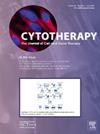Identification and culture of meniscons, meniscus cells with their pericellular matrix
IF 3.7
3区 医学
Q2 BIOTECHNOLOGY & APPLIED MICROBIOLOGY
引用次数: 0
Abstract
Background aims
Meniscus injury is highly debilitating and often results in osteoarthritis. Treatment is generally symptomatic; no regenerative treatments are available. “Chondrons,” articular chondrocytes with preserved pericellular matrix, produce more hyaline cartilage extracellular matrix and improve cartilage repair. If meniscons exist in the meniscus and have similar therapeutic potential as chondrons, employing these cells has potential for meniscus cell therapy and tissue engineering. In this study, we isolated and cultured “meniscons,” meniscus cells surrounded by their native pericellular matrix, and investigated cell behavior in culture compared with chondrons.
Methods
Human meniscons were enzymatically isolated from osteoarthritic menisci and cultured up to 28 days in fibrin glue. Freshly isolated meniscons and chondrons were analyzed by histology and transmission electron microscopy. We used 5-([4,6-dichlorotriazin-2-yl]amino)fluorescein hydrochloride labeling and type VI collagen immunohistochemistry to image pericellular matrix after 0 and 28 days of culture. Gene expression was quantified using real-time polymerase chain reaction and DNA content and proteoglycan production were analyzed using biochemical assays.
Results
Meniscons were successfully isolated from human meniscus tissue. The pericellular matrix of meniscons and chondrons was preserved during 28 days of culture. Meniscons and chondrons had similar cell proliferation and proteoglycan production. Meniscons and chondrons expressed similar levels of collagen type I alpha 1 chain, whereas collagen type II alpha 1 chain and aggrecan expression was lower in the meniscon population.
Conclusions
Freshly isolated meniscons and meniscons cultured for 28 days share similarities with chondrons with regard to cell proliferation, morphology and biochemical activity. Rapid isolation of meniscons (45 min) demonstrates potential for one-stage meniscus regeneration and repair, which should be confirmed in vivo.
半月板细胞及其细胞外基质的鉴定和培养。
背景目的:半月板损伤非常容易使人衰弱,通常会导致骨关节炎。治疗方法通常是对症治疗,目前还没有再生疗法。"软骨 "是一种保留了细胞外基质的关节软骨细胞,可产生更多的透明软骨细胞外基质,改善软骨修复。如果半月板中存在半月板细胞,并具有与软骨细胞类似的治疗潜力,那么利用这些细胞进行半月板细胞治疗和组织工程学研究将大有可为。在这项研究中,我们分离并培养了 "半月板细胞",即被其原生细胞外基质包围的半月板细胞,并研究了与软骨细胞相比,半月板细胞在培养过程中的行为。通过组织学和透射电子显微镜对新鲜分离的半月板和软骨进行分析。我们使用 5-([4,6-二氯三嗪-2-基]氨基)盐酸荧光素标记和 VI 型胶原免疫组化技术对培养 0 天和 28 天后的细胞外基质进行成像。基因表达采用实时聚合酶链反应进行量化,DNA 含量和蛋白多糖生成采用生化测定法进行分析:结果:从人体半月板组织中成功分离出半月板。在 28 天的培养过程中,半月板和软骨的细胞外基质得以保存。半月板和软骨具有相似的细胞增殖和蛋白多糖生成。半月板和软骨表达的Ⅰ型胶原α1链水平相似,而半月板群体中Ⅱ型胶原α1链和凝集素的表达较低:新鲜分离的半月板和培养 28 天的半月板在细胞增殖、形态和生化活性方面与软骨相似。快速分离半月板(45 分钟)显示了单阶段半月板再生和修复的潜力,这一点应在体内得到证实。
本文章由计算机程序翻译,如有差异,请以英文原文为准。
求助全文
约1分钟内获得全文
求助全文
来源期刊

Cytotherapy
医学-生物工程与应用微生物
CiteScore
6.30
自引率
4.40%
发文量
683
审稿时长
49 days
期刊介绍:
The journal brings readers the latest developments in the fast moving field of cellular therapy in man. This includes cell therapy for cancer, immune disorders, inherited diseases, tissue repair and regenerative medicine. The journal covers the science, translational development and treatment with variety of cell types including hematopoietic stem cells, immune cells (dendritic cells, NK, cells, T cells, antigen presenting cells) mesenchymal stromal cells, adipose cells, nerve, muscle, vascular and endothelial cells, and induced pluripotential stem cells. We also welcome manuscripts on subcellular derivatives such as exosomes. A specific focus is on translational research that brings cell therapy to the clinic. Cytotherapy publishes original papers, reviews, position papers editorials, commentaries and letters to the editor. We welcome "Protocols in Cytotherapy" bringing standard operating procedure for production specific cell types for clinical use within the reach of the readership.
 求助内容:
求助内容: 应助结果提醒方式:
应助结果提醒方式:


